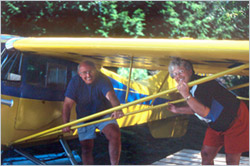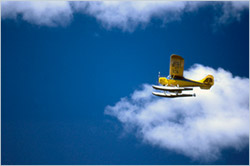by Laurel Lippert,
When you become a pilot, you join a helpful community. Being stranded at an airport somewhere gives you a chance to see just how supportive it can be.
Finding yourself stranded somewhere might seem like the worst fate if you’re a pilot, but, more often than not, it turns out to be a pleasant surprise.
With our first airplane, a 1946 Aeronca Champ, and other old slow planes that followed, we learned that since we couldn’t outrun any approaching bad weather, we could be stuck at unfamiliar airports on any cross-country flight.
As a result, we developed a motto that could apply to any adventure:
- Stay flexible
- Be open-minded
- Allow fate to redesign the trip
- And welcome opportunities to improve on the original plan.
One summer, on a long flight from Truckee, California, to Vermont in our 1946 Cessna 140, a shiny two-seater that cruised at a speed slightly faster than a covered wagon, we found ourselves stranded at Elliot Lake in Ontario, Canada. When my phone call to flight service for a weather briefing confirmed that we would be grounded for at least a day, we considered our options for getting to town—seven miles away with no public transportation.

As we stared at the gray skies from the small airport terminal, the airport manager, a burly guy with grease-stained coveralls, chatted with a couple who had just come in. They introduced themselves as Harold and Ivy Fisher and asked us about our old Cessna and showed us a photo on the wall of their homebuilt airplane. Within a few minutes, the Fishers invited us to stay with them, even though we had just met and their home was 15 miles north—an obvious inconvenience for them when we needed to return to the airport the next day.
While we gathered our things, we learned that Ivy had phoned her friends to ask if we could be included in a dinner party planned for that evening. Soon we found ourselves sharing an elegant turkey dinner with the Regans, their longtime friends who have built and restored airplanes with the Fishers for 30 years.
Overlooking the lake the next morning from Harold and Ivy’s deck, we watched as white caps formed while Harold correctly forecast high winds that would keep the Cessna 140 on the ground. The next afternoon, as the wind softened, Harold took each of us up for a scenic flight over the surrounding lakes and forests in his 1947 Aeronca Chief floatplane.
We spent three nights with the Fishers. Ivy cooked and brewed pot after pot of coffee while we talked about flying experiences, the idiosyncrasies of floatplanes and tailwheel aircraft, and life in general. They graciously included us in their social plans and made us feel at home.

When the weather finally cleared, we said a reluctant good-bye to our new friends and took off into clear blue skies toward the green mountains of Vermont.
The Fishers belong to a flying community well-known to pilots. It’s a special “club” that requires only a pilot’s license and the love of flying to join. The members make for a built-in rescue team of fellow pilots at thousands of small airports around the country who are eager to lend a hand, loan a car, offer a room, and save the day.
Our time with the Fishers reaffirmed our motto, and added another chance to experience the generosity and trust of people who share our love of flying and airplanes. Four years later, we still keep in touch with Harold and Ivy, and we eagerly await their arrival in Truckee one day, so that we can give back a little of what they gave to us. If not the Fishers, then we look forward to meeting other pilots who might be stuck in Truckee and need a ride, a bed, or a reason to improve on their original plan.
About Laurel
Laurel Lippert is coauthor of You Can Fly! with Greg Brown. It is an inspiring guidebook to understanding and appreciating the process of learning to fly. Laurel began flying at age 40. Over the next ten years, she earned her instrument and multi-engine ratings, as well as her commercial and flight instructor certificates. She has written about flying for Mountain Pilot, Pilot Getaways and Plane & Pilot magazines, as well as for ipilot.com.




